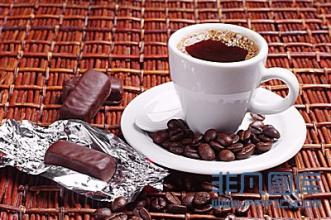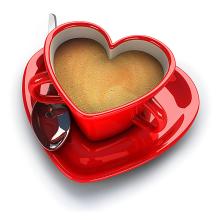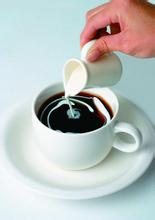"8 yuan coffee" stirs up the prosperous business circle, relying on the "cabbage price" to break through the market?
Seeing a steady stream of customers from the nearby milk tea shop, why is my coffee shop so empty? Anyone who runs a coffee shop knows that one of the key points in selling coffee is that fewer people drink and consume less frequently.
Recently, however, in the bustling business district, a wave of "cabbage-priced coffee" is on the rise.
"10 yuan freshly ground coffee", "8 yuan boutique cup". These affordable coffees appear not only in cross-border menus such as KFC and Coco, but also on the small blackboards of some independent cafes as their main products.
How on earth should we play when the price is so low?
[1]
In the bustling business area, "cabbage price" coffee is popular.
Abu Abu, an independent cafe at the "veteran" level in Zhengzhou, opened its new store in a shopping mall more than three months after closing its office building, with "10 yuan freshly brewed coffee" as its main product.
"I want more people to drink a good cup of coffee, 10 yuan coffee is the easiest way to achieve."
"even if you don't like coffee, you can give it a try."
Lao Chen, of Modu, is also brewing a low-cost coffee brand.
From Italy to Shanghai, Lao Chen has been in the beverage industry for more than ten years. Not long ago, he left a well-known company and began to prepare his own cafe.
"for 80 cents of coffee beans, make 80 cents of coffee for only 8 yuan." Lao Chen said.
Do not know since when, not only KFC, 7-Eleven convenience stores, bakeries and other cross-border people, some independent cafes like Abu Abu, also began to sell affordable coffee, and even become a wide range of menu "main products".
The thought of selling coffee in this way has something to do with the downturn in consumption in the coffee market in recent years. Relative to the level of public consumption, the higher price of coffee keeps coffee floating above the product itself.
From the market point of view, the broader mass coffee market is obviously a price-sensitive market.
The popular milk tea shop where a hundred flowers blossom is a ready-made case. 10 yuan is obviously closer to the average consumer's psychological price for a drink. The price of cabbage and coffee objectively lowers the threshold of its attempt.
The price of milk tea, which is close to the people, soon won the mass market
Ji Ming, the first president of the Beijing Coffee Industry Association, said that lower-priced coffee is beneficial to the cultivation of the domestic market.
[2]
Where does the profit come from?
Unlike independent cafes in streets and alleys, 8-yuan and 10-yuan "cabbage price" coffee frequently appears in the city's bustling business circles.
"because it is sold cheaply, the key to profitability lies in volume."
In order to increase the flow, the bustling business area is the most important site selection scheme for "cabbage coffee". The problem of passenger flow has been solved, but what about profits?
An industry insider helped Sister Fei to do a sum of money.
Calculated on the basis of 50 yuan / pound (454g) of coffee beans from the factory-this price can already get good coffee beans, 180g coffee powder 2000ml products, 360ml (12 ounces) a cup.
If you count the cost of raw materials alone, the cost of a cup is 3.6 yuan, and the gross profit is 64% if you sell it for 10 yuan.
It earns 11.4 yuan for 15 yuan a cup, which is three times the cost of raw materials.
It sounds wonderful, but if you follow the traditional mode of operation of independent cafes, once you add manpower, marketing, operation and rent, the profits will almost be eroded.
Among other things, the rent alone is enough for cafe owners to sigh.
High rent can bring high flow, and then use high flow to fill the high rent, which has to be said to be an awkward situation of affordable coffee.
Reducing the spatial experience seems to be the only way out for low-cost coffee.
Moving from "Lou Cafe" to shopping malls, the space for customers' consumption has shrunk from more than 100 "to 30". In July, the newly opened Abu Abu sold 688 cups of coffee. When the weekend is good, you can sell 60 cups a day.
Although the number of cups sold has increased several times, Xiaowu said that because of the low price, "you don't start to make a profit until you sell 50 cups a day."
Lao Chen's idea is to do stall stores like COCO to reduce rental costs. Even more powerful-"1 square meter shop, 1 coffee machine, 1 person, 1 cup of coffee per minute."
The core issues considered by Lao Chen and Xiaowu are choosing a prosperous business area with large passenger flow, minimizing operating costs such as rents, relying on high-quality and inexpensive coffee products, lowering the consumption threshold and increasing consumption.
[3]
Before the low price, calculating the cost is the key!
For coffee, do you believe in "one cent at a price", or do you believe that "the goods are both beautiful and cheap"?
In fact, for many industries, the problem of beauty and low price is not difficult to solve. It is not uncommon for us to pay attention to the restaurant enterprises that are moving towards brands and large-scale, and the price is friendly to the people and popular.
For example, the grandparents who are popular all over the country, the price is not high, the taste is excellent, coupled with the fashionable dining environment, it has a very high performance-to-price ratio for consumers, a reasonable queue, and a lot of money for the boss.
Behind the high quality and low price, its core competitiveness lies in the optimized cost structure-the low supply chain cost brought by centralized procurement and the standardized cost advantage brought by the central distribution center.
In the field of coffee, although there are factors such as the transportation distance of raw materials and imperfect relevant standards, the industrial chain appears to be somewhat mixed. But fortunately, at least in terms of the categories of upstream supply that need to be integrated, the restaurant is not too complicated.
Compared with the traditional coffee shop business, affordable coffee needs to be considered and mastered more, first of all, the secret of operating cost.
-- how to optimize the upstream supply cost? How many stores have the lowest cost and the highest profit? How to standardize the product? How to optimize inventory? How many employees have the best profit in the store? .
If we do not properly calculate the cost structure and just blindly cut prices in the face of the trend, with traffic but no profit, we will end up drinking poison to quench thirst.

Important Notice :
前街咖啡 FrontStreet Coffee has moved to new addredd:
FrontStreet Coffee Address: 315,Donghua East Road,GuangZhou
Tel:020 38364473
- Prev

Barista professional skills competition opens registration channel
A simple cup of coffee with rich flowers has become a work of art, and the exquisite of this work of art lies in the barista's skillful hands. In order to speed up the training of high-skilled personnel in the field of coffee and tea service industry in Nanhu District, and to show the unique style and superb skills of coffee and tea culture, the reporter learned from the Bureau of Human and Social Security in Nanhu District that it is sponsored by the Bureau and West Dianjia in Jiaxing City.
- Next

Hainan Yunnan Coffee commonness Yunnan small Grain Coffee introduction to Hainan Xinglong Coffee Flavor
The key to coffee is freshness. In fact, due to the fact that there is no fresh coffee in the process of production and circulation, there is no comparison between coffee powder or Nestle coffee, because the taste of coffee has lost most of it. So there will not be much difference in comparison. Of course, the taste of coffee powder should be better than that of Nestl é. So from my point of view
Related
- A complete list of coffee bean names and their meanings! What is Yejia Shefi coffee? Where is Mantelin coffee?
- What grade does Arida Manor Kaduai coffee beans belong to? What treatment is Arida ASD slow anaerobic sun exposure?
- The milk tea cup becomes smaller?! Overlord Tea Girl launches a new "Return to Yunnan" series
- Accused of selling counterfeit and high-priced coffee beans! Well-known boutique coffee brand "Oukelao" bowed and apologized!
- How to make espresso dumplings? Can I eat coffee and glutinous rice balls together?
- Save the unformed and stagnant powder cakes in one second! What is the problem with stagnant water in the powder bowl of the espresso machine?
- What does hand-brewed coffee stop mean? Why is it not recommended to make coffee by hand?
- Is it normal to smell like coffee? Why does coffee smell like alcohol? What's wrong with the strong smell of cold extract ice dripping ice brewed coffee?
- How to solve the problem that hand-brewed coffee extraction takes too long? Why is the water flowing so slowly when making coffee?
- The main points of making Australian white coffee, the proportion details, how does Australian white properly foam and blend the flowers?

